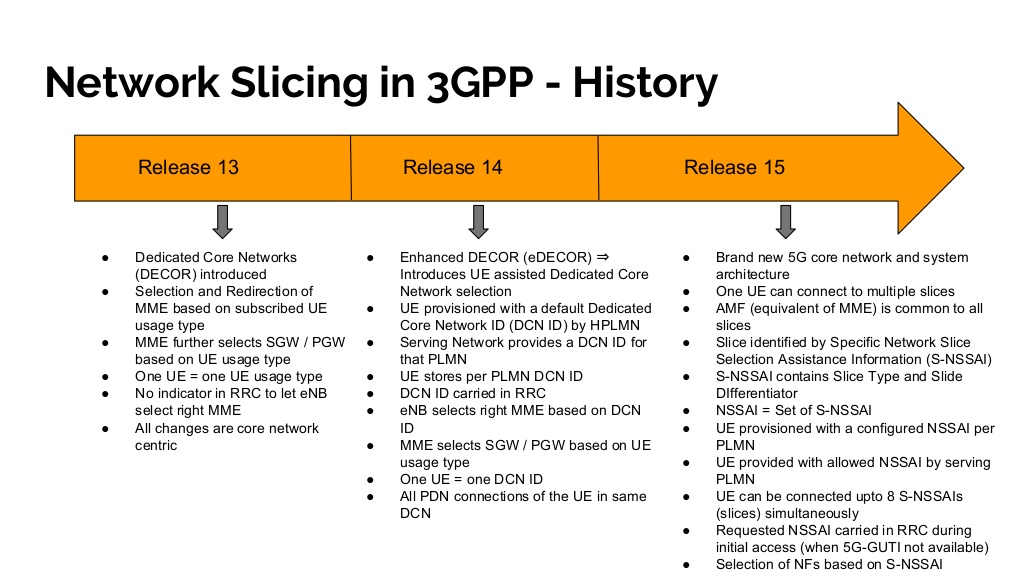Introduction
In this article, we’ll understand the physical meaning of network slicing and its history, its role in the 5G network, How 3GPP is contributing to enhancing this concept, and finally will discuss the opportunities and challenges for network slicing for operators.
Network slicing enables operators to configure virtual network instances and make them together, instantiated automatically, and optimized to meet specific functional requirements of a subscriber or application. Network slicing requires the optimal deployment of user requirements and network functions and resource exclusivity on end-to-end 5G infrastructures to provide the desired quality of service.
In order to instantiate and design a network slice, it is important to bring together the business requirements, network resource availability, user equipment subscription, and operator policies.
The ultimate goal of 5G networks is to automate the industry. To achieve this goal, there are three key requirements for 5G networks:
- Guaranteed SLA (Service-Level Agreement).
- Secure network isolation.
- Independent service operations.

One network cannot efficiently provide SLA guarantee for all services, or cannot implement network isolation and independent operations.
What is network slicing in 5G?
It can be defined as a network configuration that allows multiple networks (virtualized and independent ) to be created on top of a common physical infrastructure. This configuration has become an essential component of the overall 5G architectural landscape. Each “slice” or portion of the network can be allocated based on the specific needs of the application, use case, or customer.
While services like smart-parking meters value high reliability and security are more forgiving with respect to latency, others (like driver-less cars) may need ultra-low latency (URLLC) and high data speeds. Network slicing in 5G supports these diverse services and facilitates the efficient reassignment of resources from one virtual network slice to another.
Network slicing is a foundational concept for 5G wireless and wireline networks and can be utilized in many different ways. It is useful to differentiate between a few salient levels of usage of network slicing, which is also likely to map to phases of adoption:
- Network Slicing can be used for operational purposes by a single network operator, to differentiate characteristics and resources for different broad classes of services.
- Network slicing can be used by a service provider seeking to establish a virtual service provider network over the infrastructure of a physical network operator.
- Network slicing can allow individual end customers (enterprises) to be able to customize a virtual network for their operations and consume these networks resources in a more dynamic way similar to today’s cloud services (i.e. dynamically varying scale, or for temporary needs).
- Network slicing can allow for “traffic splitting” across networks (5G, 4G, and WiFi via hybrid fiber-coax).
Network slicing and 3GPP Activities
3GPP is the principal standards organization engaged in architecture development for 5G. Several iterations of standards releases have established a foundation for the current phase of slice-specific activity.
Since 3GPP R13 Dedicated Core Network (DÉCOR), 3GPP has been defining methods that enable different types of devices to be served by different packet core sub-networks instances. The path to network slicing functionality has been laid by enhanced DÉCOR (eDÉCOR) in R14 standards and fully realized with the work on network slicing within the R15 System Architecture for the 5G System (3GPP TS 23.501).

Network Slicing In 3GPP
3GPP R15 specifications support eMBB slicing and have been frozen.
- Slice management plane, Overall network slice management, and orchestration architecture.
- Slice control plane, Standard S-NSSAI-based signaling, and NF selection.

Service-based network slicing in the Release 15 3GPP specifications
3GPP R16 specifications specify enhanced network slice capabilities and have been frozen.
- Slice management plane, Dynamic slice SLA monitoring & adjustment, and Intention-driven management and automation.
- Slice control plane, URLLC, and MIoT slice signaling procedures.
Challenges and Opportunities for Network Slicing
The benefits are clear since a single network can be divided to cover diverse use cases based on customer demand and segmentation. Operators can then allocate resources to each slice, utilizing the necessary speed, throughput, and latency to cover the breadth of network slicing in 5G.
The ability to offer a network slice as a service minimizes operating expenses (OPEX) as well as capital expenditures (CAPEX). It can allow critical public entities, such as first responders and medical emergency teams, to be prioritized with respect to coverage, capacity, and connectivity.
While network slicing is a requisite component of 5G, the opposite is not true. Unlike other fundamental elements of 5G, it can be deployed on existing 4G/LTE, so the benefits can be realized in the short term while preparing for the forthcoming transition.
The Challenges
There are still many challenges that remain for operators and developers. Full E2E network slicing includes implementation in the radio access network (RAN), but these RAN’s will need to be redesigned to accommodate network slicing. Although progress towards standardization continues, full industry consensus on network slicing deployment on 5G networks with other architectural elements remains ambiguous.
The addition of more networks over the same physical infrastructure creates added stress for operators. Difficulty maintaining SLA, QoS, and security assurance for each individual slice and managing the spectrum slicing and allocation for highly dynamic scenarios are among the common challenges.
References:
- Network Slicing for Beyond 5G Systems: An Overview of the Smart Port Use Case.
- A Canvass of 5G Network Slicing: Architecture and Security Concern.
- 5G Network Slicing white paper by FCC.
- 3GPP TS 23.501.

